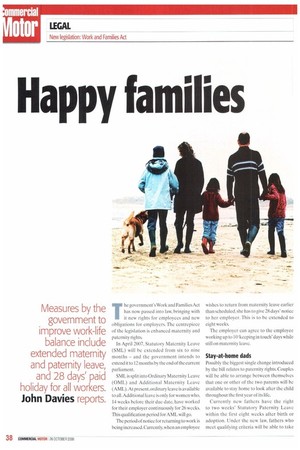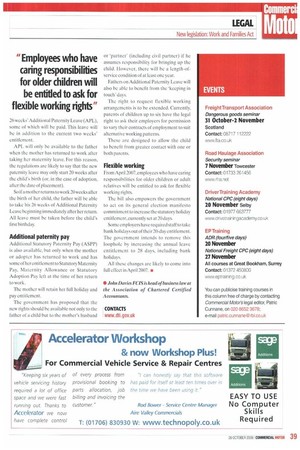Happy fami 1 ies
Page 38

Page 39

If you've noticed an error in this article please click here to report it so we can fix it.
Measures by the government to improve work-life balance include extended maternity and paternity leave, and 28 days' paid holiday for all workers.
John Davies reports.
The government's Work and Families Act has now passed into law, bringing with it new rights for employees and new obligations for employers. The centrepiece of the legislation is enhanced maternity and paternity rights.
In April 2007, Statutory Maternity Leave (SML) will be extended from six to nine months — and the government intends to extend it to 12 months by the end of the current parliament.
SML is split into Ordinary Maternity Leave (OML) and Additional Maternity Leave (AML). At present, ordin ary leave is available to all.Additional leave is only for women who, 14 weeks before their due date, have worked for their employer continuously for 26 weeks. This qualification period for AML will go.
The period of notice for returning to work is being increased. Currently, when an employee wishes to return from maternity leave earlier than scheduled, she has to give 28 days' notice to her employer. This is to be extended to eight weeks.
The employer can agree to the employee working up to 10 'keeping in touch' days while still on maternity leave.
Stay-at-home dads
Possibly the biggest single change introduced by the bill relates to paternity rights. Couples will be able to arrange between themselves that one or other of the two parents will be available to stay home to look after the child throughout the first year of its life.
Currently new fathers have the right to two weeks' Statutory Paternity Leave within the first eight weeks after birth or adoption. Under the new law, fathers who meet qualifying criteria will be able to take 26 weeks' Additional Paternity Leave (APL), some of which will he paid. This leave will be in addition to the current two weeks' entitlement.
APL will only be available to the father when the mother has returned to work after taking her maternity leave. For this reason, the regulations are likely to say that the new paternity leave may only start 20 weeks after the child's birth (or, in the case of adoption, after the date of placement).
So if a mother returns to work 20 weeks after the birth of her child, the father will be able to take his 26 weeks of Additional Paternity Leave beginning immediately after her return. All leave must he taken before the child's first birthday.
Additional paternity pay
Additional Statutory Paternity Pay (ASPP) is also available, but only when the mother or adopter has returned to work and has some of her entitlement to Statutory Maternity Pay, Maternity Allowance or Statutory Adoption Pay left at the time of her return to work.
The mother will retain her full holiday and pay entitlement.
The government has proposed that the new rights should be available not only to the father of a child but to the mother's husband or 'partner' (including civil partner) if he assumes responsibility for bringing up the child. However, there will be a length-ofservice condition of at least one year.
Fathers on Additional Paternity Leave will also be able to benefit from the 'keeping in touch' days.
The right to request flexible working arrangements is to be extended. Currently, parents of children up to six have the legal right to ask their employers for permission to vary their contracts of employment to suit alternative working patterns.
These are designed to allow the child to benefit from greater contact with one or both parents.
Flexible working
From April 2007, employees who have caring responsibilities for older children or adult relatives will be entitled to ask for flexible working rights.
The bill also empowers the government to act on its general election manifesto commitment to increase the statutory holiday entitlement, currently set at 20 days.
Some employers have required staff to take bank holidays out of their 20-day entitlement. The government intends to remove this loophole by increasing the annual leave entitlement to 28 days, including hank holidays.
All these changes are likely to come into full effect in April 2007. • • John Davies FCIS is head of business law at the Association of Chartered Certified Accountants.
CONTACTS www.dti.gov.uk
























































































































































































